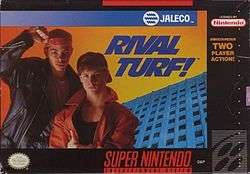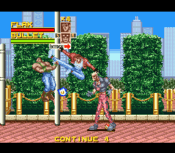Rival Turf!
| Rival Turf! | |
|---|---|
 North American cover art of Rival Turf! | |
| Developer(s) | Jaleco |
| Publisher(s) | Jaleco |
| Designer(s) | Ryoichi Kuramochi |
| Programmer(s) |
Takeshi Ohara Hitoshi Sekiya Manabu Shirato |
| Artist(s) |
Nobuyuki Kuramochi Keiichi Maekawa Tadahiko Watanabe Masahito Takahashi |
| Composer(s) |
Yasuhiko Takashiba Atsuyoshi Isemura |
| Series | Rushing Beat |
| Platform(s) | Super Famicom/SNES, Virtual Console |
| Release date(s) |
Super Famicom/SNES Wii Virtual Console Wii U Virtual Console |
| Genre(s) | Beat'em up |
| Mode(s) | Single-player, Co-op, Versus |
Rival Turf!, released in Japan as Rushing Beat (Japanese: ラッシング・ビート), is a beat'em up video game that was released by Jaleco in 1992 for the Super Nintendo Entertainment System and later on Nintendo's Virtual Console. The game is the first installment in the Rushing Beat trilogy, which also includes Brawl Brothers and The Peace Keepers, although the games were localized as unrelated titles in North America.
Plot
Jack Flak's girlfriend Heather has been kidnapped by Big Al and his gang the Street Kings. He enlists the help of his friend, police officer Oswald "Oozie" Nelson to rescue his girlfriend and rid the city from the reign of the Street Kings once and for all. They start out by heading to the sports stadium to find out more information and locate Big Al's hideout.[1]
Gameplay

The player controls one of two characters: Jack Flak (Rick Norton in Japan) or "Oozie" Nelson (Douglas Bild in Japan) in a one or two player mode, to defeat a plethora of enemies using punches, kicks and various weapons collected throughout the course of the game. The game also includes an "angry" mode where the character becomes temporarily invincible and more powerful after taking too much damage. Moving the character is done using the four-direction controller and each move (attack, jump, special attack) is done using three of the four available buttons near the movement keys.
The game also has a two-player versus mode. In the versus mode, the player who wins two wins out of three rounds wins the entire match.
Japanese version
One night, Rick Norton is walking down the streets of the city when he was surprised by a gun in the darkness. The mystery man behind the gun said that Norton's sister had an important video tape and was being held hostage. A new stimulant was being sold in epidemic amounts throughout the city and was only first manufactured a few years ago. Realizing that the organization's mystery was shrouded other than their sales of illegal stimulants, Norton has seen the city become slowly devastated over a period of time. He had to go to the city stadium in an attempt to rescue his sister Maria.[2]
Characters
- Jack Flak/Rick Norton
- The hero of the video game who is out to rescue his girlfriend Heather. The flying kick and the back drop are his specialty attacks. In the Japanese version, he is known as Rick Norton and must rescue his sister Maria from the gang.
- Oswald "Oozie" Nelson/Douglas Bild
- Police officer who likes to use powerful professional wrestling moves. The color of Nelson's skin was darkened somewhat from the Japanese version.
Localization
The North American version removed the introductory story the original Japanese game had. It also shortened the ending and removed the credits. When each character died in the Japanese version, their image is replaced with the Japanese word for death (死) while the North American version showed a simple "X" for fighters who are killed. Another feature unique to the Japanese version was the ability to change the number of lives and continues that the player could use.
The fictional city of "Neo Cisco" used in the Japanese version became the real-life city of Los Angeles in the North American version.
Reception
| Reception | ||||||||
|---|---|---|---|---|---|---|---|---|
| ||||||||
In 2010, Damien McFerran of NintendoLife reviewed the title negatively, calling it "desperately short on originality" with "truly uninspiring gameplay". He supposed that the publisher's main strategy was to capitalize on the lack of two-player functionality in Capcom's superior competing game Final Fight, while simultaneously plagiarizing it. He described the effort as "inferior ... in practically every single way imaginable" to that "infinitely more distinguished" game. He describes the characters as "painfully similar" to and "obvious replicas" of those in Final Fight, though they "look like they've wandered off the set of a Vanilla Ice music video" and have completely unrealistic movements, collision detection, and physics. The only redeeming qualities he found to the entire game are the presence of two-player mode and the ability to run.[4]
In 2011, IGN rated Rival Turf! at 4 out of 10, calling it "an almost entirely forgettable beat-'em-up with a boring premise, bland music and partially broken gameplay". The review laments "stiff animation, a lacking storyline and characters that have no discernable personality"; and the "poor collision detection" is said to define the game as an overall failure at "the most critical component of a brawler". The review states that this game lacks even the minorly distinctive features of its numerous and similar competition, generally summarizing it as being "as vanilla as the brawler genre can be".[3]
In 2010, Nintendo Power also ridiculed the box cover art, saying that "The marketing people on this game actually had a pretty outside-the-box idea, which should have really stayed off the box. After all, who is the target audience going to find more intimidating than thugs their own age?".[5]
References
- ↑ Story of Rival Turf at Giant Bomb
- ↑ Story of Rushing Beat at Plala.or.jp
- 1 2 Thomas, Lucas M. (May 5, 2011). "Rival Turf Review". IGN. Retrieved June 2, 2015.
- ↑ McFerran, Damien (October 9, 2010). "Rival Turf!". NintendoLife. Retrieved June 2, 2015.
- ↑ "Nintendo Power". No. 3. March 2009. p. 58.
External links
- Rival Turf! at MobyGames
- Rushing Beat at Jaleco (Japanese)